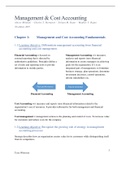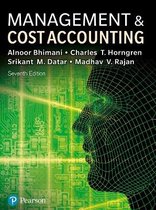Management & Cost Accounting
Alnoor Bhimani – Charles T. Horngren – Srikant M. Datar – Madhav V. Rajan
7th edition, 2019
Chapter 1: Management and Cost Accounting Fundamentals
1.1 Learning objective: Differentiate management accounting from financial
accounting and cost management.
Financial Accounting = focused on Management Accounting = it measures,
external reporting that is directed by analyses and reports (non-)financial
authoritative guidelines. Principles define a information to assists managers in achieving
set of rules and reporting tools to provide goals for the organization. It’s is an
information to outside parties. integrated part of management, to formulate
business strategy, plan operations, determine
investment decisions, control operations,
inform stakeholders etc.
Past-performance Future-oriented
Financial Accounting Management Accounting
Cost Accounting = it measures and reports (non-)financial information related to the
organization’s use of resources. It provides informative for both management and financial
accounting.
Cost management = management actions to the planning and control of costs. To increase value
for customers and reduce costs for the company.
1.2 Learning objective: Recognize the growing role of strategy in management
accounting processes
Strategy describes how an organization creates value for its customers while distinguishing itself
from its competitors.
1
Tessa Witteveen
,Two broad strategies:
- Cost leadership = providing products at low prices by managing costs (Ryanair)
- Product differentiation = offering unique products at high prices (Apple, Bang&Olufsen)
Management accountants help formulate strategy by providing information on the sources of
competitive advantage and its performance compared to its competitors. But also to monitor and
evaluate strategic process after implementation.
Innovation and digitalization enables companies to shift their focus from the masses to individual
needs of customers. Artificial Intelligence and Big Data are new aspects that enter the spectrum
of management accounting.
1.3 Learning objective: Identify five broad purposes of accounting systems.
Management accounting uses systems for these 5 broad purposes:
1. Formulating overall strategies and long-range plans
New product development, investment in assets, market-, supplier-, and customer reports.
2. Resources allocation decisions such as product and customer emphasis and pricing
Reports on the profitability of products and services, business units, distribution channels.
3. Cost planning and cost control of operations and activities
Reports on revenues and costs, assets and liabilities
4. Performance measurement and evaluation of people
Compare actual to planned results.
5. Meeting external regulatory and legal reporting requirements where they exists
Providing standardized financial reports for external stakeholders.
1.4 Learning objective: Understand how accounting can influence planning,
control and decision making
Planning Budget
Performance
Control Reports
Actions
Accounting
Systems
Performance
Evaluation
2
Tessa Witteveen
,Planning = choosing goals, predicting results under various ways of achieving those goals, and
then deciding how to attain the desired goals.
Budget = the quantitative expression of a plan of action and an aid to the coordination and
implementation of a plan.
Control = covers both the action that implements the planning decision and deciding on
performance evaluation and the related feedback that will help future decision making.
Management by exception = the practice of concentrating on areas not operating as expected
and placing less attention on areas operating as expected.
A good plan provides enough flexibility for managers to adapt to unforeseen opportunities at the
time the plan was made. In no case should control mean that manager cling to a pre-existing plan
when events indicate a better alternate direction.
Management control is primarily a human activity that tends to focus on how to help individuals
do their jobs better.
Feedback = involves managers examining past performance and systematically exploring
alternative ways to improve future performance.
1.5 Learning objective: Distinguish between the scorekeeping, attention-directing
and problem-solving functions of management accounting.
Management accountants perform 3 important functions:
1. Scorekeeping = the accumulation of data and the reporting of reliable results to all levels
of management. Accountants have the responsibility for the reliability of the reports. This
function is often automatized to free up time to spend on attention directing or problem
solving.
2. Attention directing = to make opportunities and problems visible on which managers
need to focus. Should consider all opportunities that add value, not just reduce costs.
3. Problem Solving = the comparative analysis undertaken to identify the best alternatives
in relation to the organization’s goals. Which possible solution works best?
1.6 Learning objective: Recognize the economic benefits, costs as well as
contextual and organizational process issues are relevant to accounting systems
design and operation.
Criteria for choosing among accounting systems is how well will the system achieve its intended
goals in relation to the costs.
The functioning of management accounting systems is affected by behavioral, social and
technical factors. The new system must be compatible with the values and inclinations of its
users. Assessing context and process issues can be useful in choosing and designing accounting
information systems.
3
Tessa Witteveen
, 1.7 Learning objective: Understand how companies add value.
Value chain = the sequence of business functions in which utility (value) is added to the
products and services of an organization.
Product Customer
R&D Production Marketing Distribution
Design Service
Management accounting helps manager responsible for the overall strategy to decide how
resources are to be obtained and used in order to add value to a product to be sold to its
customers.
Customer Relationship Management (CRM) = system to integrate people and technology in
all business functions and deepen relationships with customers, partners and distributors.
Supply chain = the flow of goods, services and information from cradle to grave, regardless of
whether those activities occur in the same organization or other organizations.
Key success factors = are factors that directly affect the economic viability of the organization.
Customers demand ever increasing performance regarding:
- Cost: reduce costs of their products or services
- Quality: increase levels of quality, no tolerance for low quality
- Time: time to develop, response time to customer requests, delivery times etc.
- Innovation: a prerequisite for success is the continuing flow of innovation.
- Sustainability: development and implementation of strategies to achieve long-term goals,
including environmental goals.
Continuous improvement by competitors creates a never-ending search for higher levels of
performance within organizations. So, many organizations continually concentrate on improving
different aspects of their own operations. Benchmarking is often used to set the target.
1.8 Learning objective: Explain why digitalization is management accounting’s
most important challenge today.
In the economy the use of new technologies has made possible the shift from selling mass-
market, generic products to operating in more profitable niches with special purpose products.
The use of digital technologies changes the business model and provides new revenue
possibilities.
The accounting professional needs to upskill, so they can play a role in assessing and
implementing emerging digital technology-driven approaches to management decision making.
Huge volumes of data have become available to firms to create opportunities. More refined
forms of data analytics provide accountants to support financial planning and management
action.
4
Tessa Witteveen





